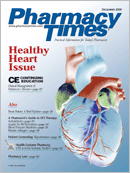Publication
Article
Pharmacy Times
Esophageal Acid Exposure in GERD
Transient lower esophageal sphincter relaxation (TLESR) isthe major contributor to esophageal acid exposure during theday. At night, the major contributor is reflux during absent basallower esophageal sphincter (LES) pressure. R.C.H. Scheffer, MD,and colleagues investigated the relationship between esophagealacid exposure time and the underlying manometric motorevents in patients with gastroesophageal reflux disease(GERD). Postprandial esophageal motility and pH were evaluatedin 31 patients. Additionally, 10 patients underwent 24-hourambulatory manometry and pH recording.
In the 3-hour postprandial study, there were 367 refluxepisodes; 79% were associated with TLESR, 14% with absentbasal LES pressure, and 7% with other mechanisms. Theseresults represented 62%, 28%, and 10% of the acid exposuretime, respectively. Acid reflux duration per motor mechanismwas longer for absent basal LES pressure than for TLESR (189± 23 sec and 41 ± 5 sec, respectively; P <.001).
In the 24-hour ambulatory study, the contributions of TLESRto reflux frequency compared with acid exposure time were 65%versus 54% interprandially and 74% versus 53% postprandially.During the night, absence of basal LES pressure accounted for36% of reflux events, representing 71% of acid exposure time.These results suggested that the duration of esophageal acidexposure after TLESR is shorter than reflux during absent basalLES pressure. (The findings were reported in Neurogastroenterologyand Motility, October 2005.)







